
Learn about Aromatherapy and Essential Oils from home
- Develop a foundation for the safe use of Aromatherapy oils; and their production.
- An introductory level course in Using Herbs
- Suitable for those wishing to gain knowledge of using Aromatherapy in the home or for those working in a related discipline.
This is a well rounded course that covers all aspects of aromatherapy - from the plants that are used in aromatherapy, to extraction, to properties of essential oils and their safe usage.....and more!
Knowing the botanical names of plants and how they are derived is an important part of Aromatherapy. Most people know essential oils by their common names, such as Lavender, Thyme or Eucalyptus. For instance, there are several different types of plant that are commonly known as Lavender, and more than one of these plants are used to produce lavender oil. Oil distilled from True Lavender, or Lavandula angustifolia, is the highest quality lavender oil. However, lavender can also be distilled from Lavandula x intermedia and Lavandula latifolia. All three smell very similar, and can even be confusing for an experienced aromatherapist, but the chemical composition of Lavandula angustifolia is far superior to the other two species and is a much better therapeutic oil.
All this and much more is explained in detail and with practical tasks in the course.
One of our Aromatherapy students said about the course:
"This course was very interesting, challenging and very worthwhile" N. Mills
COURSE STRUCTURE
There are 8 lessons as follows:
1. Plant Identification
Understand the classification system used for naming plants and to be able to identify the family, genus and species names of plants used to produce essential oils. Define aromatherapy and its history, to understand how aromatherapy works, and the basic chemistry behind it.
2. Introduction to Aromatherapy
Learn to define aromatherapy and its history and to understand how aromatherapy works, and the basic chemistry behind it
3. Essential Oils
Identify a range of essential oils, their uses and contraindications
4. Safe Use of Essential Oils
Ensure that essential oils are used in a safe and controlled manner.
5. Carriers
Identify what can be used as a carrier for essential oils and why they must be used.
6. Growing and Harvesting Herbs for Essential Oil
Identify methods which can be used to grow, and harvest herbs used in essential oil production.
7. Methods of Extraction
Identify methods used to extract essential oils from plants.
8. Hazardous Herbs and Oils
Identify herbs and oils acknowledged as hazardous to people, and which should not be used in aromatherapy, or with great care.
WHAT YOU WILL DO IN THIS COURSE
- Undertake brief written report on what you understand about how plants are named
- Give the scientific names of ten different plants from which essential oils are derived.
- Give a brief summary of your knowledge of aromatherapy and essential oils.
- Understand how herbs are promoted to the public in order to sell them.
- Write an essay on the history of aromatherapy and essential oil use.
- Suggest different blends that can be used for insomnia and other complaints
- Suggest different blends that can be used for treating a head cold.
- Discuss a range of oils that would be suitable for a travel kit
- Understand the use of aromatherapy for children.- List a range of oils that would be considered safe to use for children.
- Write a short essay on ways in which essential oils can be used.
- Understand the use of essential oils on animals.
- List a range of types of vegetable oils appropriate for use in massage and indicate what types of skin the oils are good for.
- Explain how oils enter the body and how a carrier will assist with this entry.
- Submit the bath oil blends from a Set Task along with instructions on how to use them in the bath and what conditions they are good for.
- Understand why some herbs tend to be collected in the morning, some before flowering, some during flowering, and others at various times of the year. What impact does this have on the essential oil?
- From catalogues collected, explain why some oils cost more others.
- Discuss different methods of oil extraction and list their benefits and disadvantages.
- Comprehend what is the difference between an essential oil and an aromatic oil
- Compile a detailed costing for processing herb materials to produce essential oils.
- List a range of essential oils that are not safe for use in aromatherapy.
- Discuss how essential oils can be used safely and ways in which they should not be used.
- Understand which essential oils may not be safe for use during pregnancy.
Some Scents to Entice You
Rose Otto – Rosa centifolia
This oil is the queen of essential oils. Rose Otto is the oil obtained from the petals of the flower, and the quantity of petals needed to produce the oil makes it prohibitively expensive. A good alternative, though still very expensive, is Rose Absolute, which is a solvent extracted oil using petals, leaves and stems of the plant to produce the oil. While not as effective as Rose Otto, it is still a high quality oil and can be used for the same purposes. Very little is needed in a blend to obtain the benefits of either oil. Use caution when buying Rose Otto or Rose Absolute. If the price seems comparative to that which you are paying for other oils, check the label and you will usually find that the oil has been blended into a carrier or combined with different oil. The oil is strongly floral and sweet.
Physical Conditions
|
Nervous Conditions
|
Contraindications
|
|
Bronchitis, Candida, Eczema, Dermatitis, Dry Skin, Inflammation, Menopause, Light Periods, Period Pain, Sensitive skin, Thread Veins, Wrinkles
|
Anxiety, Depression, Frigidity, Insomnia, Mental Fatigue
|
No special precautions needed
|
Rosemary – Rosmarinus officinalis
In the past, Rosemary was burnt in the corridors of hospitals in France to help to purify the air. While it has successfully been used in the treatment of epilepsy, it has also been known to trigger an attack and should be avoided by an epileptic unless used under the close guidance of a qualified Aromatherapist. The oil is fresh and herbaceous with a slightly medicinal odour.
Physical Conditions
|
Nervous Conditions
|
Contraindications
|
|
Acne, Bruises, Catarrh, Cellulite, Constipation, Cramps, Cuts, Cystitis, Earache, Flu, Fluid Retention, Gout, Indigestion, Muscle Pain Rheumatism, Sprains, Sinusitis, Varicose Veins
|
Depression, Headache, Mental Fatigue, Migraine
|
Neurotoxic. Avoid in pregnancy. Avoid in epilepsy and fever.
|
Sandalwood – Santalum album
This oil is often identified as a "Man's" oil. It has an earthy scent that many people enjoy and is also very relaxing oil. The oil has a rich, woody and yet delicate aroma.
Physical Conditions
|
Nervous Conditions
|
Contraindications
|
|
Asthma, Bronchitis, Cellulite, Chapped skin, Diarrhoea, Dry skin, Eczema, Haemorrhoids, Inflammation, Laryngitis, Nausea, PMS, Varicose Veins
|
Anxiety, Depression, Insomnia
|
No special precautions needed
|

Tips for Creating a Scented Garden
There is nothing quite like a fragrance drifting throughout a garden over summer. Fragrances become more intense as temperatures rise into summer.
- Beware of Allergies Though
- Some fragrant plants such as jasmine and honeysuckle can cause problems for allergy sufferers. Ask your neighbors before planting such things on a fence line.
Garden scents arise from either flowers or foliage.
Many fragrant plants have both scented flowers and leaves.
Plants with only fragrant foliage have one main advantage over those with fragrant flowers: the fragrance is in the garden all year round.
Most of them also have one major disadvantage: the leaves must be brushed to release the fragrance.
When fragrant foliage is stood on, crushed, or in many cases just lightly brushed, aromatic oils are released into the air to create a fragrance in the garden. To get the full benefit of fragrant foliage, it needs to be planted alongside a path or somewhere where it will be brushed or bruised regularly.
PLACES TO PLANT AROMATIC FOLIAGE PLANTS:
- Low fragrant plants between pavers that will be stood on where they spread onto the paver.
- Beside a door or gate which will knock the plant when opened.
- Beside the washing line (Where you can brush the foliage when you hang the washing).
- Beside the letterbox, where it will be knocked by the postman.
- Beside a pond where it may be knocked by birds or other animals coming to drink.
- Beside an outdoor living area, where it is handy for you to crush a leaf when sitting outside.
PLANTS WITH SCENTED FOLIAGE
Here are some suggestions of scented plants for you to try in your garden:
ALLIUM (Onion like plants)
Onion, garlic, chives and shallots are all Alliums. There are also many other, often very attractive plants in this group. The scent can vary from one type to another, but it is generally strong and pungent like an onion or garlic.
ANGELICA (Angelica archangelica)
A herb to 2.5m tall with large palm like sweet scented leaves. Angelica plants flower in the second year and then die.
ARTEMISIA (Wormwood, Southernwood, Tarragon etc).
A large variety of scented foliage plants are grouped into the Artemisias. They are mostly very hardy plants well suited to dry, sunny places. Most artemisias are ideal as a hedge plant.
CALENDULA (Calendula officinalis)
A low but hardy annual flower also called pot marigold, calendulas thrive in full sun and well drained soil. The foliage has a subtle, not strong scent.
CHAMOMILE (Anthemis nobilis)
There are several varieties of chamomile, all with scented foliage, though the most popular is the lawn chamomile (A. nobilis).
CHRYSANTHEMUMS
Chrysanthemums are best known as the colourful flowering Mothers Day plant in Australia. Though widely grown in the southern states of Australia, the chrysanthemum is often avoided in the north because of wet summers. If you spray for fungus, avoid watering the foliage, feed well and ensure good drainage, it is quite possible to succeed in subtropical areas.
Most chrysanthemums have strongly scented foliage.
CITRUS
Lemon, Orange, Cumquat and other citrus all have scented foliage. Citrus are able to be grown in most parts of Australia. Some (eg: Lime) require a warmer, sub tropical climate, and others (eg: Lemon) will tolerate very cold conditions (eg: Hobart).
CONIFERS
There are many hundreds of conifers, all with a similar, typical, resinous scented foliage. There are however some subtle differences in the scent from one to another. Conifers also have the benefit of requiring minimal care and pruning.
DIOSMA (Coleonema pulchrum)
Diosma is one of the most widely grown garden plants we have. Related to citrus and boronia it's leaves have the same type of "tangy" scent common to citrus and boronia.
LEMON VERBENA (Aloysia triphylla)
A deciduous shrub to 3m tall with clusters of white flowers over summer.
Edible leaves have a strong lemon scent. A native of tropical America, lemon verbena is frost tender and requires a moist but well drained soil.
OTHER SCENTED FOLIAGE PLANTS
Here are just some of the many other scented foliage plants you may wish to try:
- Caryopteris clandonensis (Blue Spiraea)
- Choisya ternata (Mexican Orange)
- Cistus ladanifer (Rock Rose)
- Escallonia macrantha
- Laurus nobilis (Bay laurel)
- Lavendula (Lavender)
- Melissa officinalis (Lemon Balm)
- Mentha species (Mint)
- Myrtus communis (Common Myrtle)
- Origanum (Marjoram or Oregano)
- Rosmarinus officinalis (Rosemary)
- Salvia sp. (The Sages)
- Santolina (Lavender Cotton)
- Tagetes (Marigold)
- Thymus (Thyme)
ENROL AND LEARN LOTS MORE ABOUT AROMATIC HERBS, GROWING THEM, EXTRACTING OILS, AND USING THOSE OILS.